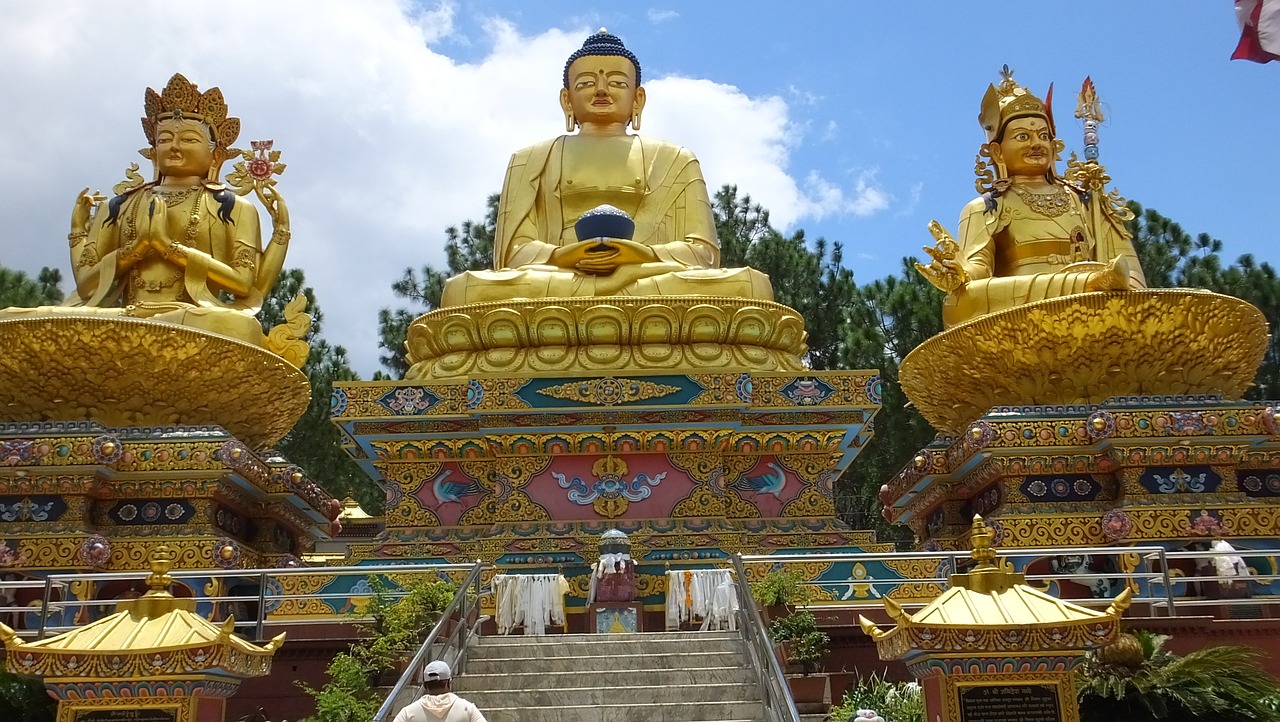Perched atop a hill overlooking the Kathmandu Valley, Swayambhunath Stupa, also known as the Monkey Temple, stands as a timeless symbol of Nepal’s spiritual heritage and cultural identity. With its gleaming white dome, gilded spire, and all-seeing eyes that watch over the city below, this ancient monument beckons pilgrims and travelers alike to ascend its sacred steps and discover the secrets of enlightenment. Join us on a journey to uncover the mystique of Swayambhunath Stupa—a place where spirituality meets serenity amidst the chaos of urban life.
A Sanctuary of Serenity
As you ascend the steep staircase that leads to Swayambhunath Stupa, you leave behind the hustle and bustle of Kathmandu’s streets and enter a realm of peace and tranquility. Prayer flags flutter in the mountain breeze, their colorful hues dancing against the backdrop of clear blue skies. Monkeys playfully frolic among the ancient ruins, adding to the sense of whimsy and wonder that pervades the sacred space.
At the summit, you’re greeted by the sight of the stupa—a massive hemispherical dome crowned by a golden spire that glints in the sunlight. The stupa’s whitewashed exterior gleams with an otherworldly radiance, while the eyes of the Buddha gaze out from the four cardinal directions, their all-seeing gaze a reminder of the wisdom and compassion that lie at the heart of Buddhist teachings.
The Legend of Swayambhunath
Legend has it that Swayambhunath Stupa dates back more than 2,500 years, making it one of the oldest religious sites in Nepal. According to local folklore, the valley that would later become Kathmandu was once a vast lake, and the hill upon which the stupa now stands was an island. The Bodhisattva Manjushri, in a gesture of compassion, drained the lake with a single stroke of his sword, revealing the sacred site beneath.
The name “Swayambhunath” translates to “self-existent one,” a reference to the belief that the stupa emerged spontaneously from the earth—a manifestation of the primordial Buddha’s enlightenment. Over the centuries, the stupa has been renovated and restored by successive rulers and devotees, each leaving their mark on this sacred sanctuary of serenity.
A Place of Pilgrimage
For devout Buddhists, Swayambhunath Stupa is a place of pilgrimage—a sacred site where they can pay homage to the Buddha and seek blessings for themselves and their loved ones. Pilgrims from all corners of the globe flock to the stupa to circumambulate its base, spinning prayer wheels and chanting mantras as they walk clockwise around the perimeter.
At the base of the stupa, devotees light butter lamps and offer prayers and offerings to the Buddha and other deities enshrined within. The air is filled with the scent of incense and the sound of chanting, creating an atmosphere of reverence and devotion that permeates the entire hillside.
Exploring the Surroundings
Beyond the stupa itself, Swayambhunath is home to a wealth of other sacred sites and religious monuments. The surrounding complex is dotted with shrines, temples, and monasteries, each offering its own unique blend of architecture and spirituality.
The Harati Devi Temple, dedicated to the goddess of smallpox and other infectious diseases, is a popular pilgrimage site for mothers seeking blessings for the health and well-being of their children. Nearby, the Shantipur Temple, or “Temple of Peace,” offers a quiet retreat for meditation and reflection amidst the chaos of urban life.
Practical Tips for Visiting Swayambhunath Stupa
Before you embark on your journey to Swayambhunath Stupa, here are some practical tips to enhance your experience:
- Dress Modestly: As Swayambhunath is a religious site, it’s important to dress modestly out of respect for the local customs and traditions. Avoid wearing revealing clothing, and remember to remove your shoes before entering the stupa or any other sacred spaces.
- Respectful Behavior: Be mindful of your behavior while visiting Swayambhunath Stupa, and refrain from loud or disruptive behavior that may disturb other visitors or worshippers. Remember to observe silence in areas designated for meditation and prayer.
- Watch for Monkeys: Keep an eye out for the resident monkeys that inhabit the hillside around Swayambhunath Stupa. While they can be entertaining to watch, they can also be mischievous and may attempt to snatch food or belongings from unwary visitors.
- Stay Hydrated: The climb to the top of Swayambhunath Hill can be steep and strenuous, especially on hot days. Be sure to bring plenty of water to stay hydrated, and take breaks as needed to rest and recharge.
Conclusion: A Journey of Enlightenment
As you descend the steps of Swayambhunath Stupa and bid farewell to its gleaming white dome and all-seeing eyes, you carry with you the sense of peace and serenity that pervades this sacred sanctuary. Whether you’re a devout pilgrim seeking blessings or a curious traveler in search of spiritual enlightenment, Swayambhunath offers a journey of discovery unlike any other—a journey that transcends time and space to touch the very essence of the human soul.
So come, immerse yourself in the mystique of Swayambhunath Stupa, and let its timeless wisdom and compassion guide you on the path to enlightenment. For in the shadow of the all-seeing eyes of the Buddha, all are welcome, and all are one.


